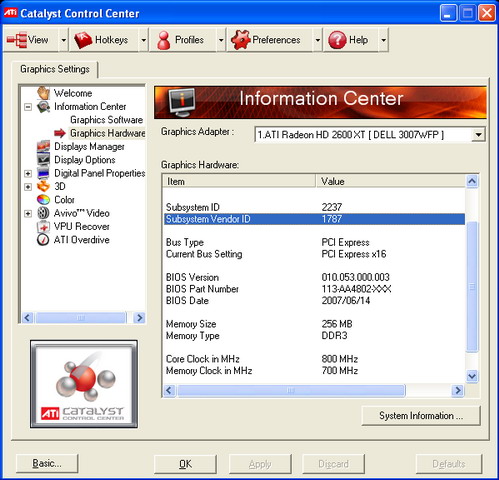So, onwards to what you all have been waiting for, the benchmarks. Does the Radeon HD 2600 XT live up to its expectations? Well, that depends on what you expect from a graphics card that should retail for around €110-130. The test system we used didn’t have Windows Vista installed on it, so you’ll have to be patient and wait for Sanjin to bring you DX10 numbers as soon as we get a card to the labs. But as a DX9 card, it performs quite well considering the lower than expected retail price.
Is it going to beat Nvidia? Well, not if you’ve already got a GeForce 8600 GTS, but it will definitely put up a battle against the 8600 GT. It will also kick the crap out of some older ATI cards like the X1650 series and even the low end X1800 cards in some games, depending on the resolution. It won’t beat the X1950 Pro though, due to the X1950 Pro’s 256-bit memory interface. It is a worthwhile upgrade if you have an older ATI card and have decided to stick with ATI, it’s also a worthy option over a GeForce 8600 GT, so it really comes down to what brand you prefer.
So what about some benchmark figures? Well, we weren’t able to run all of our standard benchmarks, partly due to time restrictions and partly due to the fact that we tested the card in PowerColor’s offices in Taiwan. This makes things slightly more difficult when it comes to comparing results. Although the system we tested the card on is similar to the system that Sanjin uses, it’s not the same spec.
The test system had an Intel Core 2 Extreme X6700 CPU, 2GB of DDR2 at 1066MHz and a DFI Lanparty UT ICFX3200-T2R/G motherboard with the ATI RD600 chipset. Not a bad machine and the results are in the general ballpark of what we would get on our test system. It was actually the same system we helped PowerColor tweak during Computex, but with a different CPU in it. We used the 8.39 rc4 drivers, which should be quite similar to the recently released Catalyst 7.6 drivers.

First up we have 3DMark 05
| 3DMark 05 | ||||
| Overall | GT1 | GT2 | GT3 | |
| 1,024x768 | 9670 | 41.6 | 30.4 | 45.7 |
| 4xFSAA | 6810 | 30.4 | 20.4 | 32.7 |
| 850/750 | 10240 | 44 | 32.1 | 48.6 |
| 1,280x1,024 | 8052 | 34.6 | 25.2 | 38.4 |
| 4xFSAA | 5385 | 23.9 | 16.1 | 25.9 |
| 1,680x1,050 | 6841 | 29.4 | 21.2 | 32.9 |
| 4xFSAA | 4461 | 19.8 | 13.2 | 21.8 |
| 1,920x1,200 | 5958 | 25.3 | 18.5 | 28.9 |
| 4xFSAA | 3784 | 16.6 | 11.3 | 18.5 |
This is the only test we had time to give a quick run with the card overclocked and a 50MHz overclock for the core and the memory has to be considered pretty good considering we didn’t spend any time trying to get the most out of this card. The performance increase is rather small, although it is large enough to make it worthwhile. It’s still shy of beating a GeForce 8600 GTS, but the GT doesn’t stand a chance, even at default speeds.
As for the test results, we only had time to test he card with 4xFSAA enabled, due to the time it takes to run all the tests. As we had a wide screen display at our disposal, we decided to run the high resolution tests at wide screen resolutions, as this is meant to be a graphics card for the wide screen HD generation. 1,680x1,050 is most likely going to be the result most people care about once you move past 1,280x1,024 as you can pick up a 20 or 22-inch LCD screen for very little money these days.
The card really starts to struggle once you pass 1,680x1,050 and it doesn’t seem like 4xFSAA being enabled either. This is most likely related to the 128-bit memory interface, as there just isn’t enough data being shifted between the GPU and the memory for FSAA to work at its best.
Next up we have 3DMark 06
| 3DMark 06 | |||||
| Overall | GT1 | GT2 | HDR1 | HDR2 | |
| 1,024x768 | 5916 | 13.8 | 17.18 | 22.58 | 30.27 |
| 4xFSAA | 4242 | 11.15 | 12.33 | 17.59 | 16.65 |
| 1,280x1,024 | 4802 | 11.74 | 14.55 | 17.68 | 22.18 |
| 4xFSAA | 3238 | 9.19 | 9.79 | 12.26 | 11.68 |
| 1,680x1,050 | 4063 | 10.15 | 12.44 | 14.79 | 17.7 |
| 4xFSAA | 2629 | 7.76 | 8.09 | 9.81 | 8.68 |
| 1,920x1,200 | 3502 | 8.95 | 10.93 | 12.54 | 14.45 |
| 4xFSAA | 2228 | 6.6 | 6.98 | 7.89 | 7.37 |
Again, the card has the same issues with 4xFSAA, although it’s still lagging behind the 8600 GTS, it’s ahead of the GT again. Nothing much else to say here really, the numbers speaks for themselves.
